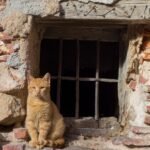The picturesque city of Iepers (Ypres) in Belgium’s West Flanders region harbors a dark secret from its medieval past. This charming destination near the French border, now known for its cat-loving culture, once practiced the systematic killing of cats from church towers. The transformation from feline persecution to celebration represents one of history’s most dramatic cultural reversals.
Today, thousands of visitors flock to Iepers for its famous Kattenstoet (Cat Festival), where the city joyfully honors the very creatures it once condemned. This remarkable journey from superstition to celebration offers fascinating insights into how societies evolve, overcome dark histories, and create new traditions that heal old wounds.
The Dark Era of Killing Cats
Image by pexels
During the Middle Ages, Iepers earned a grim reputation for its annual tradition of throwing cats from the Cloth Hall tower. This practice, dating back to the 12th century, saw live cats hurled from the 70-meter belfry during the Ascension Day fair. The ritual continued for centuries, becoming a twisted form of public entertainment.
The reasons behind killing cats varied, rooted in medieval superstition and practical concerns. Cats were associated with witchcraft and devil worship, making them targets of religious persecution. Their nocturnal nature and glowing eyes frightened superstitious townspeople who saw them as supernatural beings.
Economic factors also played a role. The Cloth Hall stored valuable textiles that attracted mice. While cats initially helped control rodents, their growing populations became problematic. The annual cat-killing served as brutal population control, wrapped in religious ceremony.
The practice reflected broader European attitudes toward cats during plague years. Many blamed cats for spreading disease, not understanding they actually helped by killing disease-carrying rats. This tragic irony led to increased rat populations and potentially worse plague outbreaks.
From Persecution to Celebration
The last recorded instance of killing cats in Iepers occurred in 1817. Changing social attitudes and growing awareness of animal cruelty finally ended the barbaric tradition. The city began its long journey toward redemption and reconciliation with its feline victims.
In 1938, Iepers launched the first modern Kattenstoet, transforming shame into celebration. The festival initially served as acknowledgment of the city’s dark past. Organizers replaced live cats with toy versions thrown from the tower, symbolically continuing tradition without cruelty.
Post-World War II reconstruction gave Iepers opportunity for complete reinvention. The city embraced its newfound role as cat protector rather than persecutor. The Kattenstoet evolved into elaborate celebration featuring giant cat floats, costumed performers, and cat-themed activities.
Today’s festival occurs every three years, attracting over 50,000 visitors. The celebration includes historical reenactments that educate about past cruelty while celebrating current enlightenment. It’s become Belgium’s unique way of confronting historical wrongs.
Modern Cat Culture in Iepers
Image by pexels
Contemporary Iepers has completely reversed its relationship with cats. Felines roam freely through medieval streets, welcomed in shops and cafes. Local businesses display cat imagery, and cat-themed souvenirs dominate tourist shops.
The city’s redemption extends beyond festivals. Animal welfare organizations thrive, and strict protections ensure cat safety. Educational programs teach children about respecting animals and learning from historical mistakes.
The transformation from killing cats to cherishing them demonstrates society’s capacity for change. Iepers doesn’t hide its dark history but uses it as teaching tool. The city proves that acknowledging past wrongs can lead to meaningful cultural evolution and healing.





